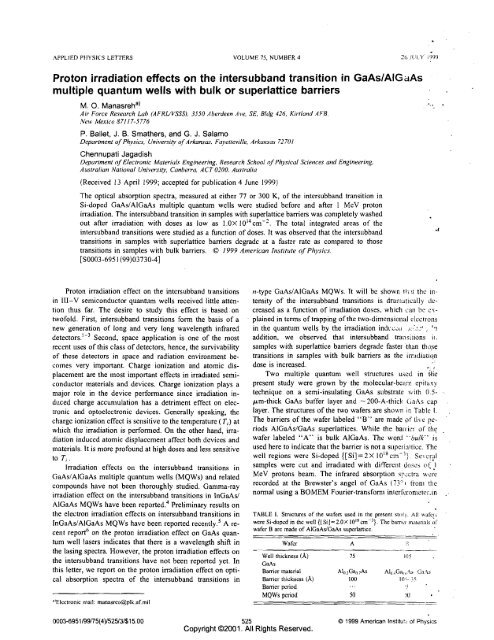Three - University of Arkansas Physics Department
Three - University of Arkansas Physics Department
Three - University of Arkansas Physics Department
You also want an ePaper? Increase the reach of your titles
YUMPU automatically turns print PDFs into web optimized ePapers that Google loves.
APPLIED PHYSICS LETTERS VOLUME 75, NUMBER 4<br />
Proton irradiation effects on the intersubband transition in GaAsIAIGaAs<br />
multiple quantum wells with bulk or si~perlattice barriers<br />
M. 0. ~anasreh~)<br />
Air Force Reseclrch Luh (AFRWVSSS), 3550 Aberdeen AIV,<br />
:Vew Mexico 87117-5776<br />
SE, Bldg 426, Kirtlawd .4FB<br />
P. Ballet, J. B. Srnathers, and G. J. Salarno<br />
Departrnenf <strong>of</strong> <strong>Physics</strong>, Uni~versie <strong>of</strong> Arkunsas. Fayeueville, Arkn~rsus 72701<br />
Chennupati Jagadish<br />
<strong>Department</strong> <strong>of</strong> Elecfronic Muferiirl.~ Engineering, Research School <strong>of</strong> Physical Scietlces utul Engineering,<br />
Australian Matior~al Univcrsi~, Cnnbew, ACT 0200. .4ustralici<br />
(Received 13 April 1999; accepted for publication 4 June 1999)<br />
The optical absorption spectra, measured at either 77 or 300 K, <strong>of</strong> the intersubband transition in<br />
Si-doped GaAslAIGaAs multiple quantum wells were studied before and after I MeV proton<br />
irradiation. The intersubband transition in samples with superlattice barriers was conlpletely washed<br />
out after irradiation with doses as low as 1.OX 10'%m-'. Thc total integrated areas <strong>of</strong> the<br />
intersubband transitions were studied as a hnction <strong>of</strong> doses. Tt was observed that the intersubband<br />
transitions in samples with superlattice barriers degradc at a fastcr ratc as compared to those<br />
transitions in samples with bulk barriers. O 1999 American Institute <strong>of</strong> <strong>Physics</strong>.<br />
[SOOO3-695 I (99)03730-41<br />
Proton irradiation effect on the intersubband transitions<br />
in 111-V semiconductor quanhim wells received little attention<br />
thus far. The desire to study this effect is based - on<br />
tw<strong>of</strong>old. First, intersubband transitions form the basis <strong>of</strong> a<br />
new generation <strong>of</strong> long and very long wavelength infrared<br />
detectors.'-3 Second, space application is one <strong>of</strong> the most<br />
recent uses <strong>of</strong> this class <strong>of</strong> detectors, hence, the su~ivability<br />
<strong>of</strong> these detectors in space and radiation environment becomes<br />
very important. Charge ionization and atomic displacement<br />
are the most important effects in irradiated semiconductor<br />
inaterials and devices. Charge ionization plays a<br />
major role in the device perfomlance since irradiation induced<br />
charge accun~ulation has a detriment effect on electronic<br />
and optoclcctronic devices. Generally speaking, the<br />
chargc ionization effect is scnsitive to the tcnlperature (Ti) at<br />
which the irradiation is performed. On the other hand, irradiation<br />
induced atomic displaccrnent affect both devices and<br />
materials. It is more pr<strong>of</strong>ound at high doses and less sensitive<br />
to 7,.<br />
Irradiation effects on the intersubband transitions in<br />
GaAslAlGaAs multiple quantum wells (MQWs) and related<br />
compounds have not been thoroughly studied. Gamma-ray<br />
irradiation effect on the intersubband transitions in InGaAsI<br />
AIGaAs MQWs have been reported.' Preliminary results on<br />
the electron irradiation effects on intersubband transitions in<br />
InGaAsIAIGaAs MQWs have been reported recently.' A recent<br />
report6 on the proton irradiation effect on GaAs quantum<br />
well lasers indicates that there is a wavelength shift in<br />
the lasing spectra. However, the proton irradiation effects on<br />
the intersubband transitions have not been reported yet. In<br />
this letter, we report on the proton irradiation effect on optical<br />
absorption spectra <strong>of</strong> the intersubband transitions in<br />
"Electronic mail: manasreo@plk.af.mil<br />
n-type GaAsIAIGaAs MQWs. It will be shown t!-i.tt thc intensity<br />
<strong>of</strong> the intersubband transitions is drauilrrically decreased<br />
as a function <strong>of</strong> irradiation doses. which can b~ tuplained<br />
in tenns <strong>of</strong> trapping <strong>of</strong> the hvo-dimensionsl clccrro~ls<br />
in the quantum wells by the irradiation indcc~~i ,(:,:,:.:+ .. r ! ~<br />
addition, we observed that intersubband traiisi~ions i ~.<br />
samples with superlattice barriers degrade faster than th~se<br />
transitions in samples with bulk bamers as the irr:rdisti~n<br />
dose is increased. .. . .<br />
Two multiple quantum well structures used in t4ie<br />
present study were grown by the molecular-bc;rm epitauy<br />
technique on a semi-insulating GaAs substrate with li.5-<br />
pm-thick GaAs buffer layer and -200-A-thick GaAs cap<br />
layer. The structures <strong>of</strong> the two wafers are shown in Table I. .<br />
The barriers <strong>of</strong> the wafer labeled "B" are made <strong>of</strong> live periods<br />
~l~a~s!~aAs superlattices. While the barlies <strong>of</strong> the .<br />
wafer labeled "A" is bulk AIGaAs. The wonl "bufk" is<br />
used here to indicate that the barrier is not a supesi:~ttice. The<br />
well regions were Si-doped {[Si] = 2 X IO'%II-'J. Se\ c~;l<br />
samples were cut and irradiated with different 4osi.s <strong>of</strong>! .<br />
MeV protons beam. The infrared absorption sI1:ctra were<br />
recorded at the Brewster's angel <strong>of</strong> Ga.4~ (77"1 from the<br />
nornlal using a BOMEM Fourier-transfoml interfcronietci..in ..<br />
T.4HLE 1. Structures <strong>of</strong> the wafers used In the present ~~LI(I) 411 ~afc!,<br />
were SI-dopcd m thc well ([SII=ZOA 101Jcm-2} The barrt~~ m.~tcr~nla ol<br />
wafer B are made <strong>of</strong> AIGaAs/GaAs supcrlatt~ce<br />
Wafcr<br />
A<br />
--<br />
Well thickness (A) 75 105<br />
GaAs<br />
Barrier material AI,,Gan7As AI,,.,G>+,,,~\a G:v\s<br />
Harrier thickness (I\) 100 ~()(...:i<br />
Barrier period<br />
...<br />
MQWs period 10 SO<br />
0003-695119917~(4)1525/31$15.00 525 0 1999 American Institu:.: <strong>of</strong> <strong>Physics</strong><br />
Copyright Q2001. All Rights Reserved.













